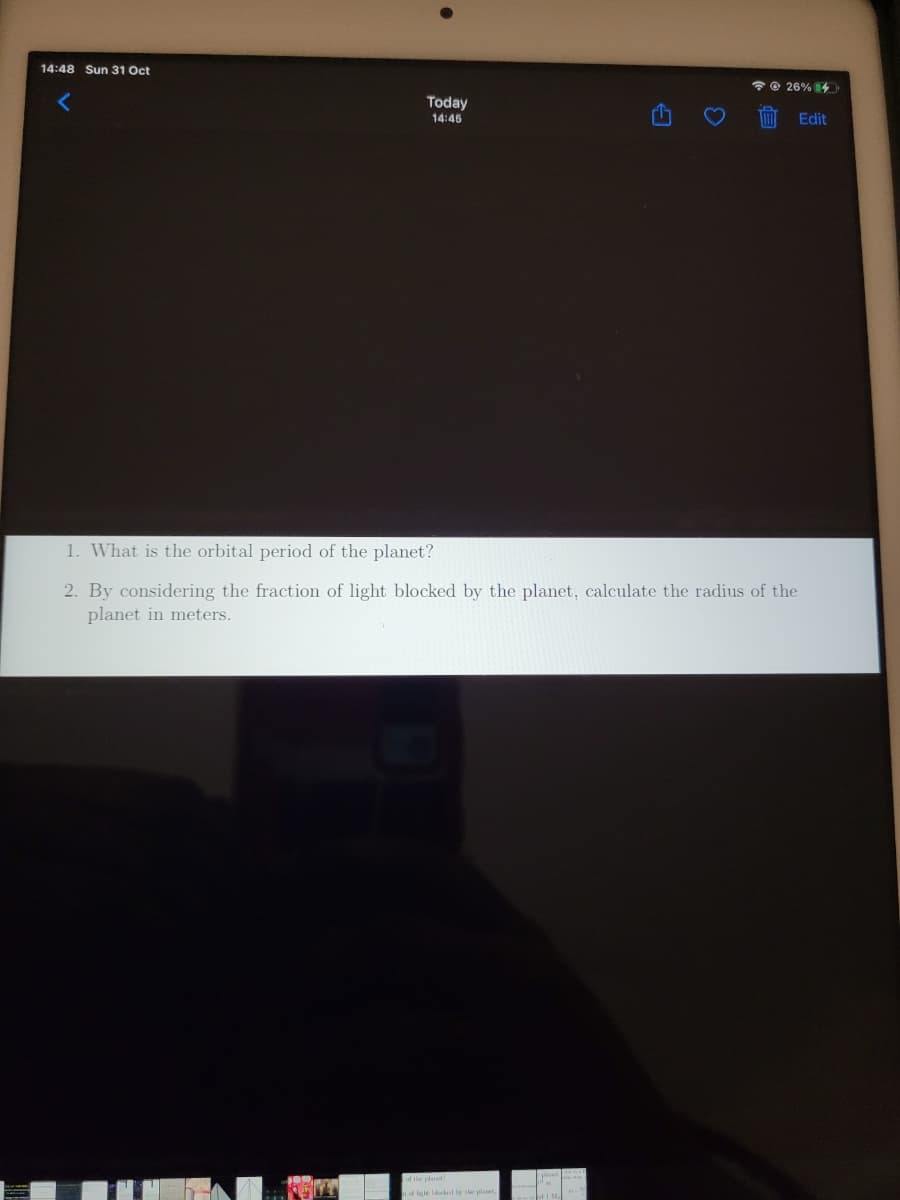Background Literally thousands of planet candidates have now been discovered via the transit method by looking for the very slight dimming of a star caused by a planet passing in front of it. In this workshop, you will determine the orbital period, radius, orbital radius, and length of transit path from the light curve of a planet. The plot below shows the intensity of light from a star during seven days, dimmed by a planet crossing in front. The star has a radius of 2x10° meters. Light Intensity 1.00 0.99 0.98 0.97 0.96 4 1 2 Time [days]
Background Literally thousands of planet candidates have now been discovered via the transit method by looking for the very slight dimming of a star caused by a planet passing in front of it. In this workshop, you will determine the orbital period, radius, orbital radius, and length of transit path from the light curve of a planet. The plot below shows the intensity of light from a star during seven days, dimmed by a planet crossing in front. The star has a radius of 2x10° meters. Light Intensity 1.00 0.99 0.98 0.97 0.96 4 1 2 Time [days]
Principles of Heat Transfer (Activate Learning with these NEW titles from Engineering!)
8th Edition
ISBN:9781305387102
Author:Kreith, Frank; Manglik, Raj M.
Publisher:Kreith, Frank; Manglik, Raj M.
Chapter5: Analysis Of Convection Heat Transfer
Section: Chapter Questions
Problem 5.39P
Related questions
Question
100%
Hi, plz show full working and explanation. Also USE INFORMATION FROM GRAPH to answer the questions. Thanks
![Today
26% 4
14:45
Edit
Background
Literally thousands of planet candidates have now been discovered via the transit method
by looking for the very slight dimming of a star caused by a planet passing in front of it.
In this workshop, you will determine the orbital period, radius, orbital radius, and length of
transit path from the light curve of a planet.
The plot below shows the intensity of light from a star during seven days, dimmed by a
planet crossing in front. The star has a radius of 2×10° meters.
Light
Intensity
1.00
0.99
0.98
0.97
0.96
6.
4
2
0 1
Time [days]](/v2/_next/image?url=https%3A%2F%2Fcontent.bartleby.com%2Fqna-images%2Fquestion%2F5f16230c-6ac5-46a3-8397-985bc6abd0ce%2F7bdf4512-334a-4d76-a42d-d4aac72fa09d%2Fjianxz_processed.jpeg&w=3840&q=75)
Transcribed Image Text:Today
26% 4
14:45
Edit
Background
Literally thousands of planet candidates have now been discovered via the transit method
by looking for the very slight dimming of a star caused by a planet passing in front of it.
In this workshop, you will determine the orbital period, radius, orbital radius, and length of
transit path from the light curve of a planet.
The plot below shows the intensity of light from a star during seven days, dimmed by a
planet crossing in front. The star has a radius of 2×10° meters.
Light
Intensity
1.00
0.99
0.98
0.97
0.96
6.
4
2
0 1
Time [days]

Transcribed Image Text:14:48 Sun 31 Oct
O 26% 4
Today
14:45
Edit
1. What is the orbital period of the planet?
2. By considering the fraction of light blocked by the planet, calculate the radius of the
planet in meters.
d the plaet
d ligle l tle plat
Expert Solution
This question has been solved!
Explore an expertly crafted, step-by-step solution for a thorough understanding of key concepts.
Step by step
Solved in 3 steps with 3 images

Knowledge Booster
Learn more about
Need a deep-dive on the concept behind this application? Look no further. Learn more about this topic, mechanical-engineering and related others by exploring similar questions and additional content below.Recommended textbooks for you

Principles of Heat Transfer (Activate Learning wi…
Mechanical Engineering
ISBN:
9781305387102
Author:
Kreith, Frank; Manglik, Raj M.
Publisher:
Cengage Learning

Principles of Heat Transfer (Activate Learning wi…
Mechanical Engineering
ISBN:
9781305387102
Author:
Kreith, Frank; Manglik, Raj M.
Publisher:
Cengage Learning